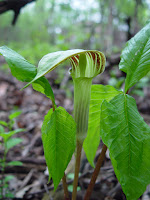 Indianpipe Monotropa uniflora is white because it contains no chlorophyll; it derives water and other nutrients by tapping into the thread-like
cells of the vegetative part of soilborne mycorrhizal fungi.
Indianpipe Monotropa uniflora is white because it contains no chlorophyll; it derives water and other nutrients by tapping into the thread-like
cells of the vegetative part of soilborne mycorrhizal fungi.It appears in forests, scattered, and uncommon. It will grow near a narrow range of mushrooms in the Russulaceae family. We saw this on a field sketching day in a nearby remnant of Big Woods.
Indianpipe is also called Ghost Plant or Corpse Plant.

































